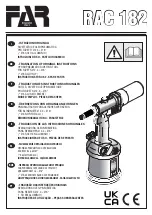
- 5 -
4.2
Functional Setting
You can select "Main unit," "Sub-unit," and an operating voltage level with the DIP switch.
Note: Be sure to turn off the dynamic braking unit when setting the DIP switch.
(1) Operating Voltage Set/Change function
The dynamic braking unit supports three operating voltage levels: Standard (factory-set), -
5%, and -10%. You can select an operating voltage level by setting the DIP switch.
When an overvoltage trip occurs at a certain voltage or deceleration time, this function
reduces the operating voltage of the dynamic braking unit to prevent an overvoltage trip.
However, at a high input voltage, only the power will be turned on braking unit.
Determine the operating voltage level according to the receiving voltage.
Receiving voltage
×
• ã
2 + 20 V < Operating voltage
(2) Parallel connection-interlocking function
You can run two parallel-connected dynamic braking units interlocked by connection of
their signal wires (MA1, MA2, SL1,and SL2) and setting of the DIP switches.
You can use one of the dynamic braking units as a sub-unit and allow it to work at the
operating voltage level of the main unit by setting the dynamic braking unit as a sub-unit by
the DIP switch.
Table 4.1 shows settings of the DIP switch.
Table 4.1 DIP switch setting
Function and operating voltage
DIP switch setting
(X: Any position)
Remarks
1
Main unit
Operating voltage: Standard
363V (725V)
OFF, OFF, ON, X
Factory-set
2
Main unit
Operating voltage: -5%
345V (689V)
ON, OFF, ON,X
3
Main unit
Operating voltage: -10%
326V (653V)
ON, ON, ON, X
4
Sub-unit
X, X, OFF, X
The operating voltage
correspond to a main unit.
The value in parentheses indicates the operating voltage of the 400V-class dynamic braking unit.













































